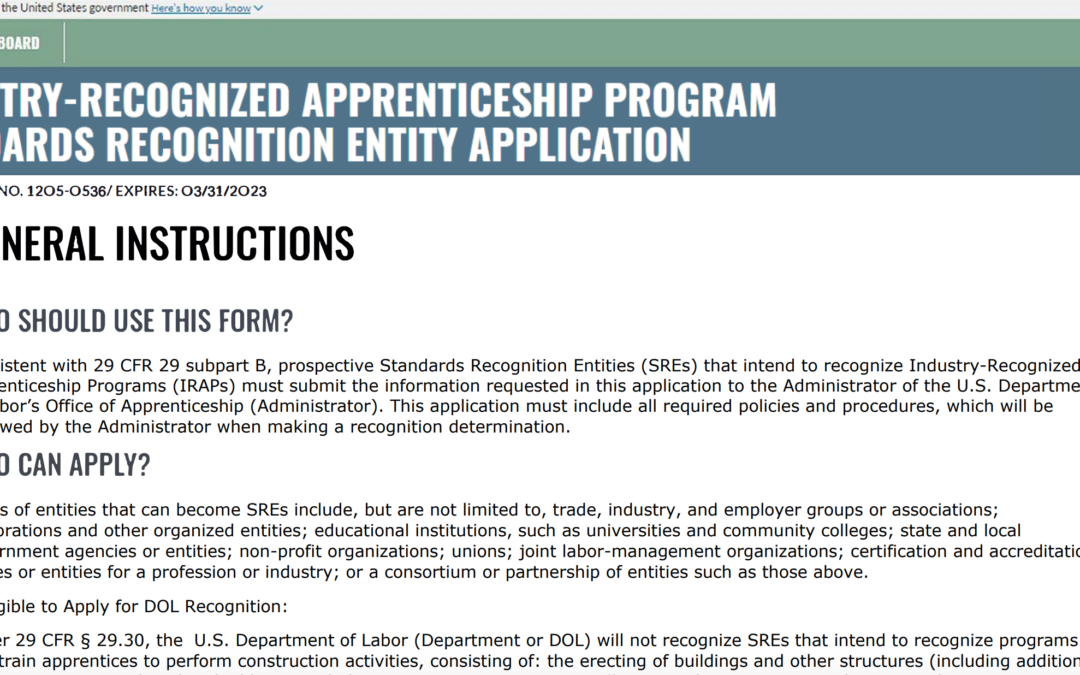The Department of Labor is in search of organizations with the capacity and interest to serve as Standards Recognition Entities (SRE). This announcement came with the release of the Final Rule in early March, which introduced a second apprenticeship pathway, Industry-Recognized Apprenticeships (IRAPs). The two go hand-in-hand because SREs will be responsible for the oversight of IRAPs.
We have some tips for groups interested in applying to become an SRE. These are based on our own experiences. But first, does your organization meet the requirements to apply for SRE status? Let’s find out.
What is a Standards Recognition Entity?
In short, SREs will be responsible for recognizing high-quality IRAPs and evaluating them on an annual basis. They must have industry expertise and access to partnerships and resources to support the administration of those IRAPs for a five-year period.
Apprenticeship.gov reports that the following types of groups might qualify for the role:
- Trade, industry, and employer groups or associations;
- Companies and other corporate entities;
- Educational institutions, such as universities or community colleges;
- State and local government agencies or entities;
- Non-profit organizations;
- Unions;
- Joint labor-management organizations;
- Certification and accreditation bodies or entities for a profession or industry; or
- A consortium or partnership of entities such as those above.
Standards Recognition Entity Responsibilities
 The DOL has referred to SREs as “industry leaders” that provide direction for apprenticeship programs and ensure quality and relevance. SREs report to the DOL.
The DOL has referred to SREs as “industry leaders” that provide direction for apprenticeship programs and ensure quality and relevance. SREs report to the DOL.
Among their responsibilities:
- Set minimum standards for IRAPs seeking recognition
- Develop and implement policies to fairly recognize IRAPs
- Develop and implement policies to fairly monitor IRAPs on at least an annual basis
- Ensure IRAPs are adhering to Federal, State, and local laws pertaining to compensation, safety, and Equal Employment Opportunity
- Suspend or derecognize non-compliant IRAPs
- Report to the DOL on IRAP program and performance data
The list does not end there. More details are available at Apprenticeship.gov.
With the right systems in place — and maybe a little help from RADD Training — SREs can add IRAP administration to their repertoire without pause.
Tips for Successfully Completing the Application
The Standards Recognition Entity application goes live on May 11, 2020. This is the same day the Final Rule goes into effect. It is available for preview on Apprenticeship.gov. Interested organizations are encouraged to get a head start.
In fact, RADD Training is in the thick of compiling and creating materials for one organization, so we are very familiar with the application.
We have several recommendations for aspiring SREs based on our experiences:
Read and Then Read Some More
Know everything there is to know about SREs by reading the documents on Apprenticeship.gov, including fact sheets, FAQs, and the preview of the SRE application. And then read them again. Maybe even one more time after that.
Choose Your Team
Now that you know the application’s ins and outs, recruit the help of three to five teammates with the right expertise to help you tackle this process. You will need a project manager who knows the big picture and will pull all of the pieces together. You also will need a few individuals to draft policies and procedures and/or adapt ones already in place. A supervisor should participate in conversations and decision-making, too.
Define Your Expectations
SREs are expected to recognize and monitor high-quality IRAPs. That means they first must define what “high quality” means in their industry. Involve your team and other industry experts in your circle. Determining this vision is arguably the most time consuming piece of the process. The team will need to agree on requirements of several components, including minimum on-the-job training hours, related instruction hours, and more.
Communicate Often
Schedule a weekly check-in meeting with all members of the team. This is an opportunity for everyone to report their progress, identify obstacles, and lay out next steps. Many side conversations might occur in the interim, even with individuals outside of the core team. A weekly meeting ensures everyone is on the same page. You might be surprised by how the project evolves!
Set Deadlines
If you are in a hurry, you can probably get all of your application materials together in four or five weeks — as long as you set deadlines and stick to them. If the task is less urgent for your organization, still set deadlines based on your goal submission date.
Step Away
As is true with any project, it is important to step away every once in a while. Allow yourself some time to absorb all of the information. This break might help you to make new connections, devise more efficient processes, or catch inconsistencies.
And Then What?
You wait. The DOL projects that the first batch of SREs will be approved in the fall of 2020. In general, the Office of Apprenticeship will process applications within 90 days.
Once approved, the recognition period for SREs is five years. SREs may reapply within 6 months of recognition expiration.
If you are interested in an expedited, smooth application process, consider adding RADD Training to your team. Contact us at rdaurio@raddtraining.com.


Recent Comments